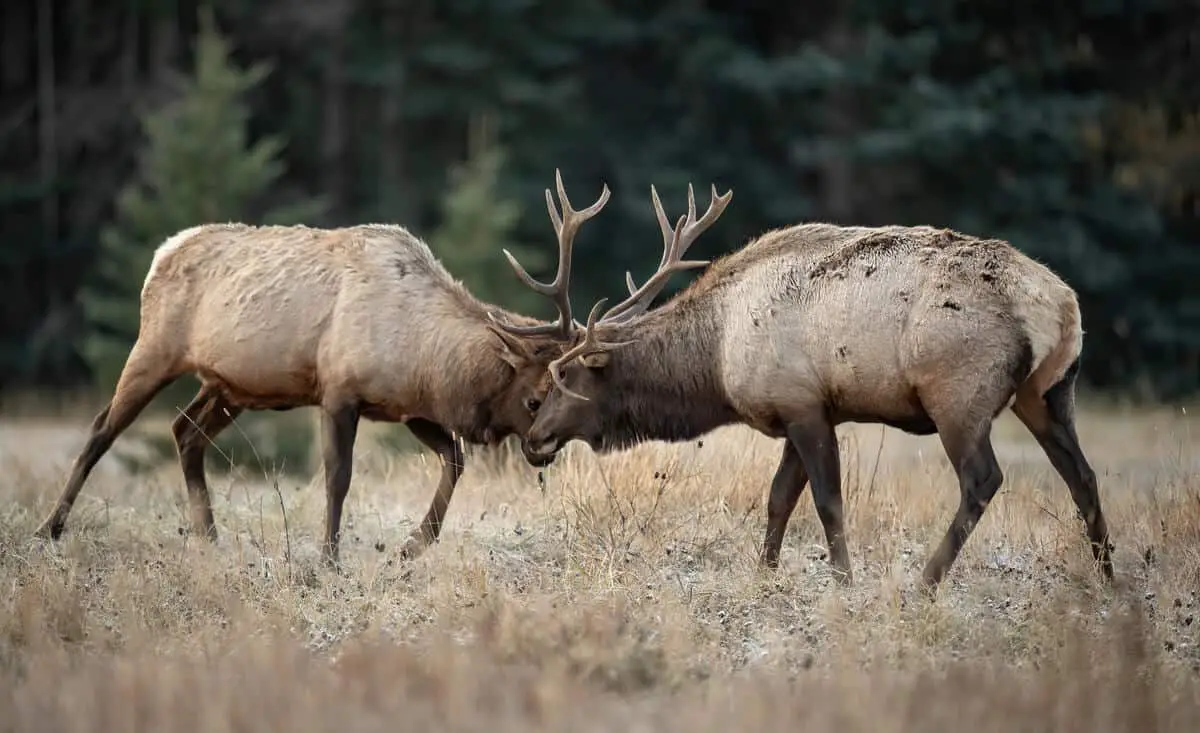Banff is home to one of the larger elk herds across Canada’s national park system, although their numbers have steadily declined over the past five years. In 2022, their number was 139 individuals. While the continuous decline is alarming, you’re almost guaranteed to spot (at least) one during your visit. If you’re wondering what’s up with these large ungulates, this post is for you!
The elk in Banff, also known as “wapiti”, may not seem as daunting as bears, nor do they have the same ferocious reputation. But their size makes them an impressive sight nevertheless.
And yes, elk can be dangerous, too. That’s why it’s good to know a thing or two about them. Especially because you can regularly spot elk near or even in town.
So, let’s have a look at what’s up with these striking mammals!
Elk in Banff National Park: When and Where to Spot
As a visitor to Banff National Park, I imagine you wonder where you can spot elk. Even though elk can be seen anywhere in the park at any time, some places and times are better than others for spotting them.
Notable Elk Viewing Areas in Banff
You have a better chance of seeing elk in some parts of Banff National Park. Here are some of the best places to put your attention:
Along the Bow Valley – This winter habitats, grassy fields and sheltered side valleys are home to large groups of elk during the winter. Also, check around the town of Banff, towards Lake Louise, the turnoff to Moraine Lake (please note: this road is closed for the winter), and the trails nearby. Both early and late light are essential.
Vermilion Lakes Road – Elk feed in these wetland fen areas near the Trans-Canada Highway, west of Banff, all year. Look for openings from your car or viewpoint. Best at sunrise and sunset.
Mount Norquay Scenic Drive – Wind up this steep mountain road north of Banff to see the Bow Valley from its overlooks. Elk may be eating on the hills or crossing below. The most exciting time is around sunrise when elk return from nighttime feeding.
The Muleshoe Picnic Area -This picnic spot along the Bow Valley Parkway (Highway 1A) overlooks a field where elk like to hang out. It’s a great place to see elk when they come out to feed at dusk or dawn.
Sundance Canyon, Johnston Canyon, and Lake Minnewanka are also great places to see elk. Your best chance is in the morning or evening, but you can find elk resting anytime. With persistence and proper timing, you’ll be rewarded with elk sightings.
Prime Seasons for Elk Viewing
Elk can be seen in Banff all year, but viewing conditions change with the season. The best time to see elk is from the middle of summer to the middle of fall when they’re grazing out in the open.
The bugling rut starts in the fall. A highlight is seeing bulls fight and bugle to attract females, but it’s not easy to find elk hiding in the woods.
Important to know is that during the bugging rut, being near elk is also more dangerous. During this time of the year, bulls are generally more aggressive.
Winter is the most challenging, yet the most rewarding season for you as a spotter. Elk gather lower where there is no snow but are well-camouflaged. When the snow is white, and the sun glints off it, animals that are dark brown the rest of the year now stand out strikingly.
Best Times of the Day for Elk Viewing
The best times to see elk are around dawn and dusk. This is when elk are most likely to move between feeding areas and places where they can sleep safely.
Even so, there is no question that you can see elk at any time of day. During the middle of the day, they often rest in wooded areas or open fields. The calves, in particular, stay busy by playing and eating grass while their mother rests.
How to View Elks Safely
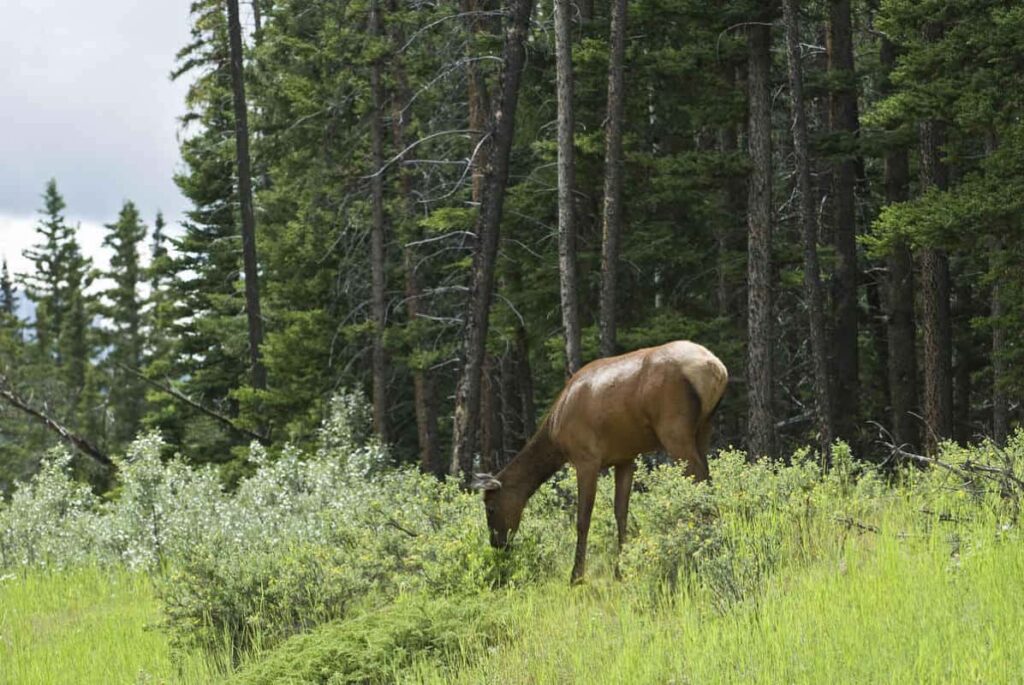
Use Caution During Rut
Elk behavior changes dramatically during the fall breeding season. When they want to mate, bulls become more aggressive and protective.
Keep at least 200 meters (219 yds) away from rutting bulls. Don’t crowd them or corner them. If confrontations arise, you should leave rutting places quickly.
Stay Away from Calving Areas
Elk cows try to find a quiet place to give birth in late May or June. Never get in the way of a calving spot. Calves that are nursing are highly vulnerable, so stay away from all cow-calf pairs.
Report Problems
If you see people getting in the way of elk or wildlife management, you should tell Parks Canada immediately so they can act. This helps prevent human-animal conflicts from getting worse.
Natural History of Elk in Banff National Park

Elk (Latin: Cervus canadensis) have a long history in Banff National Park and the surrounding Canadian Rockies.
Archaeological evidence indicates elk have inhabited this region for approximately 10,000 years since the retreat of the massive continental ice sheets during the last Ice Age.
Indigenous peoples, like the Stoney Nakota First Nations, relied on elk for food, hides and tools, sustaining a traditional way of life in harmony with the local wildlife.
The establishment of Banff as Canada’s first national park in 1885 protected resident elk populations and their wilderness habitat.
Population Size
As mentioned in the introduction to this article, the estimated elk population within Banff National Park is about 139 individuals as of 2022. As their number has declined over the past five years (per 2022), it’s unclear what caused this decline.
Of these 139 elk, 81 were female, and 58 were male. The latest survey (2022) showed a cow-calf ratio of 42 percent.
Seasonal Habitat & Range
During summer months, elk inhabit the montane regions of Banff National Park up to the subalpine zone. This includes coniferous forests, river valleys, and open meadows.
As more snow falls in the fall, elk move lower in elevation to places like the Bow Valley, which is a good place for them to spend the winter. Elk numbers and locations change seasonally, though, because of the way they move when they migrate.
Diet & Feeding Habits
Elk are ruminant herbivores that eat grasses, flowering plants, woody shrubs, trees, and mosses.
Depending on their location, they graze extensively on grasses, herbs like fireweed and horsetail, and shrubs like willow and aspen in the summer.
In the winter, elk depend more on woody browse, like needles from conifers, twigs, and leftover fall plants. Elk change what they eat based on seasonal availability.
Life Cycle & Reproduction
Cows give birth to calves from late May to mid-June after a gestation of 240-260 days. The peak calving period is late May.
Females are sexually mature at 18 months but typically give birth at 2.5 to 3 years of age. Single births are most common, with twins being rarer.
Newborns weigh 30 to 35 pounds. Weaning takes place between 6 to 8 months after birth. The conception period runs from late August through October, corresponding with the fall rut.
Bull elk reach sexual maturity at 24 months but don’t reach prime physical condition until ages 4 to 5. The average lifespan of elk is 10-13 years in the wild. In captivity, elk can live about 20 years.
Mortality Cause
Primary predators of elk in Banff include wolves, cougars, black bears, and grizzly bears. Coyotes may also prey on calves. Wolves are the main predators, targeting juveniles, seniors and ill elk.
Human-caused mortality also occurs via poaching, train or vehicle collisions, and legal elk culls (to keep elk congregating in town, for instance).
Population Dynamics
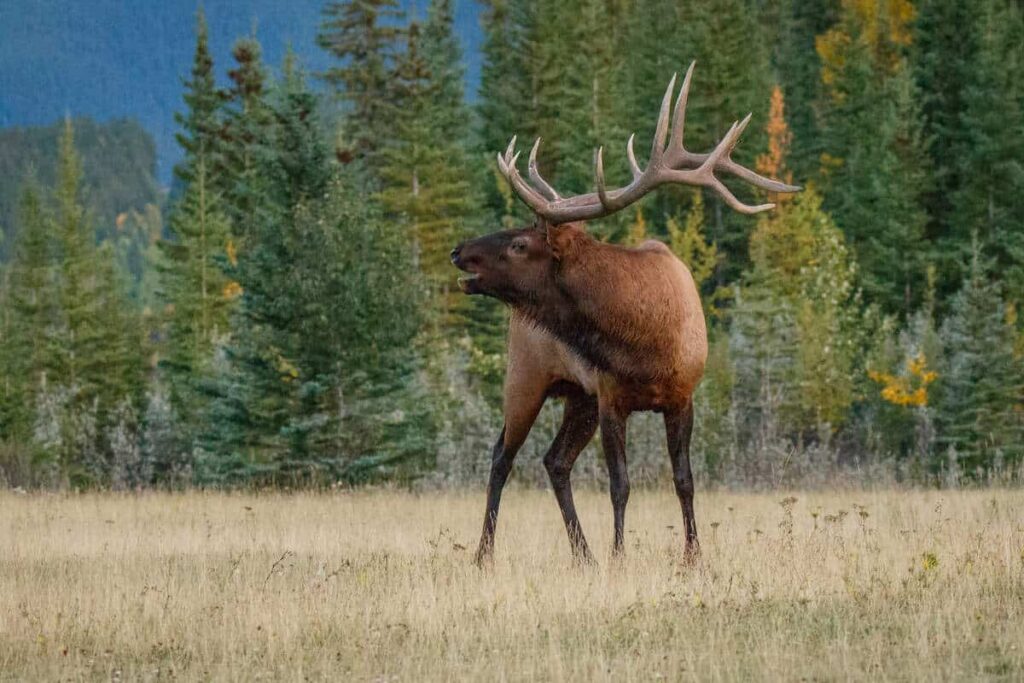
The Banff elk herd has a polygynous mating system. During the rut, the most dominant bulls form harems with a group of females to breed.
A grown bull elk can mate with up to 20 females during a season. So, the number of bulls to cows in an elk herd is off. On average, there are only 35 bulls for every 100 cows. Surveys also show that about 42 calves are born for every 100 cows yearly.
Elk Adaptations and Defenses
Elk can smell, hear, and see well enough to spot enemies that are hiding nearby. Their skin is light tan to brown, which helps them hide in the open fields.
Elk can run up to 64 kilometers per hour (40 mph) to escape predators due to their strong shoulder muscles and long legs. They use their antlers as weapons to fight off other elk or to protect themselves.
Elk Migration Patterns in Banff
GPS-collared elk studies reveal three distinct seasonal ranges occupied by Banff’s herd:
- Low-elevation winter range valleys
- Mid-elevation early winter/late spring transition zones
- High-elevation summer ranges near the treeline
Spring and fall migrations between winter and summer grounds can be anywhere from 40 to 100 kilometers (25 to 60 mi) long one way.
Elk Behavior & Life Cycle in Banff National Park
In addition to knowing where and when to see elk, how they behave and their life cycle (hopefully) gives you an improved understanding of these animals.
Social Structure & Herding Habits
Elk are highly social animals. They gather in groups called herds. In summer, females form larger nursery herds containing cows, calves of the year, and immature elk.
Dominant females lead the herds. Males gather in “bachelor groups” elsewhere until the fall rut.
During the September-October rut, mature bulls establish harems containing several females they breed with. Bulls bugle aggressively to attract cows and proclaim dominance.
Nursery herds follow regular migration patterns between their wintering and summer grounds. Migrations are led by a single cow that knows the way from experience.
Cow-Calf Behavior
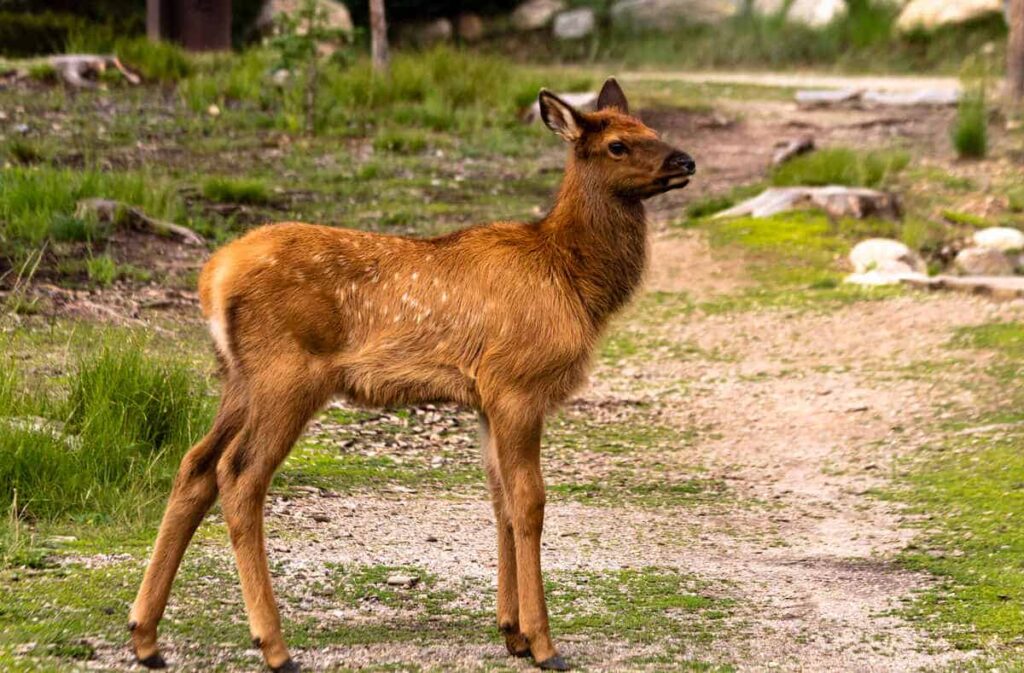
Cows give birth in secluded areas away from the larger herd and predators. Calves lay low for the first ten days while their scent diminishes to avoid attracting predators – nursing peaks in June.
Calves continue nursing for 6-7 months but begin browsing after two weeks. Cows quickly gather young if danger approaches. Calves rejoin mothers using vocal calls. Cows are very protective if separated from calves.
Rutting and Breeding Behavior
The fall rut kicks off with mature bulls migrating to traditional gathering spots.
Bulls wallow in mud pits to spread scent, thrash shrubs and trees to exude aroma from glands, bugle loudly, and urinate in specialized rutting pits.
They fight each other by clashing their antlers in dramatic sparring matches. The dominating bulls get to breed with the female harems.
Bulls Bugling
When bull elk are ready to mate in September and October, they make a loud, haunting bugle call. These sounds show other bulls that they are strong and healthy and draw female elk.
You can hear bugles for miles. They’re often passed back and forth between bulls. Bugling is common early in the morning and later in the day. Cows and calves also make sounds like chirps, barks, and mews.
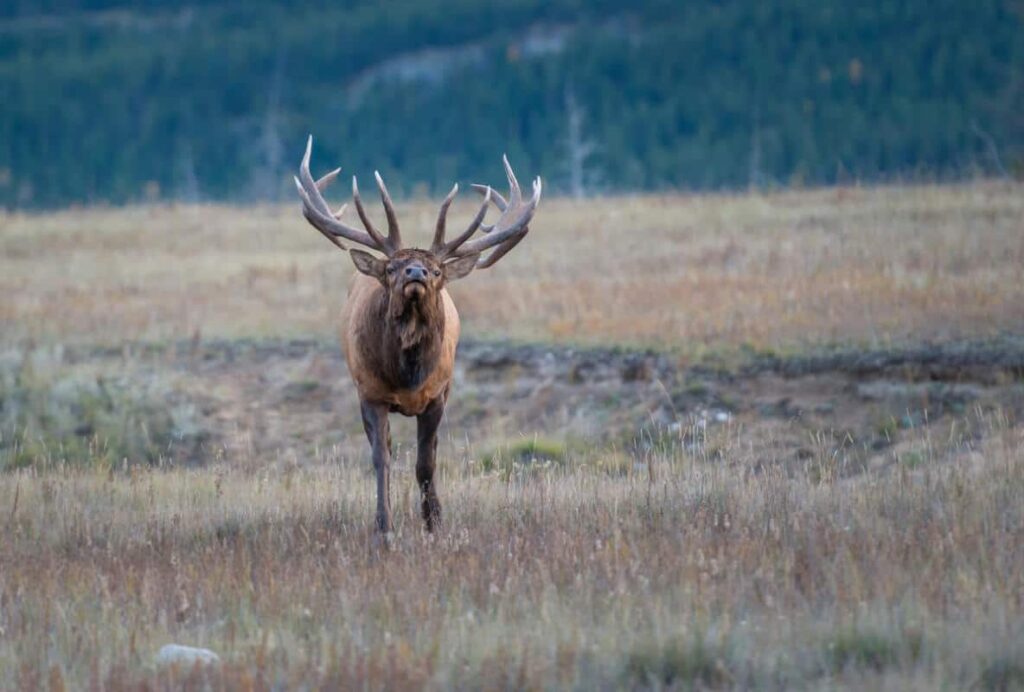
Antler Growth through Shedding
When winter ends in March, bulls lose their big horns to save energy. New antlers start to grow right away because testosterone levels are going up.
Change begins with knobs on the pedicels of the head. During the summer, the blood-filled skin on the outside of the antlers makes them grow quickly. It can grow as much as 2 centimeters (0.78 in) a day.
In late summer, the velvet shrivels and is rubbed off on trees and shrubs. Hardened antlers are used for establishing dominance and sparring rights.
Without their antlers, elk are less safe after the rut. Shedding lasts until March, completing the annual cycle.
Habitat Use and Movement Patterns
As migratory animals, elk in Banff move between different seasonal ranges. During the summer, they graze in higher alpine fields and forest openings.
In October, when there is a lot of snow, elk move downhill to lower elevations. In the winter, the range of the Bow Valley changes based on how much snow there is and how the wind blows. In harsh midwinter weather, elk reduce activity and conserve energy.
Predator Avoidance Tactics
Elk can see, hear, and smell very well, so they can quickly identify danger. Their brown color helps them hide in open fields.
If the danger increases, elk raise their tails, snort, and run away, hitting speeds up to 64 km/h (40 mph).
To avoid being seen, calves hide and lie low. Bulls can scare off predators at close range with their antlers and strong kicks.
Selected Sources
- https://wildlife.onlinelibrary.wiley.com/doi/full/10.1002/jwmg.22330
- https://wildlife.org/wolves-help-shape-how-long-elk-keep-antlers/#:~:text=Usually%2C%20bull%20elk%20shed%20their,for%20cows%20to%20mate%20with
- Parks Canada
- Rocky Mountain Outlook
- Town of Banff
- Mark Hebblewhite, Daniel H Pletscher, and Paul C Paquet. 2011. Elk population dynamics in areas with and without predation by recolonizing wolves in Banff National Park, Alberta. Canadian Journal of Zoology. 80(5): 789-799. https://doi.org/10.1139/z02-058
ALSO READ: Guide to Wildlife in Banff

